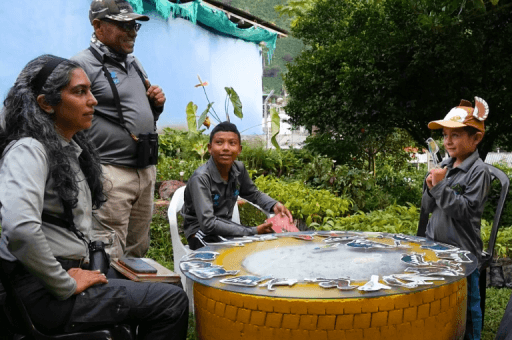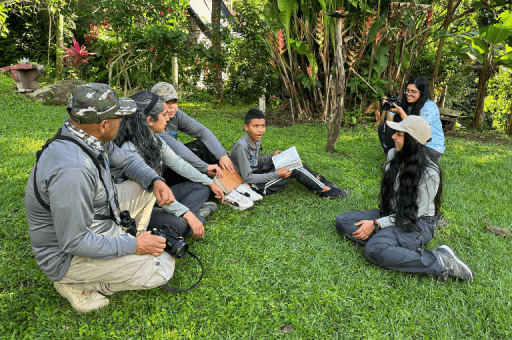Growing Coffee in Partnership with Nature and Community
During a trip to the Central Andean region of Caldas, Colombia, Erica J. Sánchez Vázquez, ABC's Multimedia Producer, learned how resident and migratory bird species benefit from habitat improvements on local coffee farms. This is Part 2 of her report on the work of Paisajes Sostenibles (PaSos), a multi-partner sustainability initiative supported by American Bird Conservancy (ABC) and led by the local nonprofit Corporación VivoCuenca. The project aims to restore degraded working lands, increase habitat connectivity, and reduce the environmental impact of coffee production, all while maintaining productivity for farmers. Read Part 1 »
“The [Paisajes Sostenibles] program seeks to create consciousness, to awaken the perspective that nature is a partner in agriculture,” said Yerson Franco, a forestry technician who collaborates with coffee growers to enhance biodiversity, as part of the Paisajes Sostenibles (PaSos) program in Colombia.
We're at Hacienda Venecia, a 500-acre coffee farm with an eBird checklist of over 300 species. Franco is showing us the many species of trees that PaSos has helped plant at this farm, in collaboration with owner Juan Pablo Echeverri. This is one of the 402 farms that the PaSos team has partnered with in the Chinchiná and Tapias-Tareas River basins.
Over the last four years, they've planted more than 170,000 trees and plants in projects supported by ABC, representing more than 160 native species. To make it all happen, the project works with 11 community nurseries and a team of forestry technicians who travel all over the territory.

Working with landowners, the technicians implement landscape management tools such as biodiversity gardens, planting trees along creeks, dispersed tree plantings, and living fences for cattle. These various planting strategies create bridges that connect forest fragments, resulting in better movement of wildlife and increased availability of food and shelter, explained PaSos coordinator Rocío Espinosa.
The changes not only benefit birds and other wildlife – trees like the guamo (Inga edulis), a large leguminous tree, contribute nitrogen to the soil, improving its quality and resulting in higher-quality coffee. They also have deeper roots that help hold the soil and prevent erosion.
In addition to habitat enhancements, the PaSos team is working to address other environmental impacts along the coffee production chain. After harvesting, each bean has to be processed, removing the pulp that covers the grain. This method usually uses high amounts of water, but PaSos is providing incentives for equipment that uses ten times less.

The traditional process also generates a great deal of pulp, which is often dumped in the nearby waterways, including important rivers like the Chinchiná. In order to reduce water pollution, the team is distributing a system that captures this byproduct and turns it into fertilizer for the farm.
These strategies have economic benefits, too: “A coffee that has good agricultural practices, that is conserving biodiversity, and that is reducing environmental impacts can help producers get better pricing,” said Espinosa.
One way that the initiative financially supports producers is through the coffee contest Café, Bosques y Aves (Coffee, Forests, and Birds). Farmers participating in PaSos submit their coffee beans to be evaluated for various quality attributes, such as acidity, aroma, and taste. Winners get a prize and their coffee is locally sold in special packaging that celebrates their commitment to birds and their forests.
“PaSos has helped me to continue working hard, for the planet's sustainability and for my pocket,” said Gerardo Carvajal, a small-scale farmer who got sixth place in the first contest.
Sowing the Seeds of Bird Conservation

We end the tour at Finca Villa del Sol, a community nursery where Jorge Osorio and Gladys Patiño run an after-school program for children. A couple of boys laugh as they quiz the adults on various bird species found in the area: Golden-winged Warbler, Yellow-billed Cuckoo, Andean Motmot.
Education and outreach are also important components of the PaSos initiative, from children's education to workshops about sustainable landscape management and participatory bird counts. Involvement from landowners and the community “allows a better grasp of the land's biodiversity, and it's part of that justification to adopt changes with their own conservation objectives,” said Espinosa.
In fact, everyone we met felt great joy and pride in having a better awareness of the birds that share a home with them, in being able to identify the three declining songbirds and other migratory birds, and in knowing how to help them.

Looking forward, the team plans to strengthen and continue building partnerships to replicate the pilot program across the Central Andes BirdScape. ABC will continue supporting the initiative and work with the partners to develop a BirdScape conservation plan for the next ten years, said ABC's Fierro-Calderón.
As I listen to the children at Finca Villa del Sol, I feel hope for the next ten years and beyond. I think about my own boy, yet to be born, and about the words of farmer Marino Cifuentes: “What will I tell my daughter if I take away the trees and the food that the birds need? What will I tell her if the birds disappear? No. I will tell her: ‘I conserve them so you can keep seeing them.”



















































